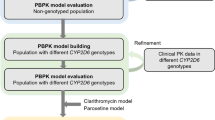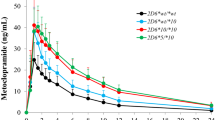Abstract
Background
Genetic polymorphisms in CYP2C9 account for 10–20% of the variability in warfarin dose requirement. As such CYP2C9 genetic polymorphisms are commonly included in algorithms aimed to optimize warfarin therapy as a way to account for variability in warfarin responsiveness that is due to altered pharmacokinetics. However, most of the currently available pharmacokinetic data were derived from studies among patients on chronic warfarin therapy and therefore suffer from the confounding effects of disease states and drug interactions.
Objective
The purpose of the present study was to provide an accurate quantitative estimate of S-warfarin oral clearance (CLS) among healthy subjects carrying different CYP2C9 genotypes.
Methods
Single dose of warfarin was administered to 150 non-smokers, age (mean ± SD) 23.3 ± 4.5 years, 60% male, non-obese, healthy subjects. Blood samples were taken for up to 168 h and urine was collected over the entire study period.
Results
Compared with carriers of the wild-type CYP2C9*1/*1 genotype (n = 69), CLS was reduced by 25, 39 and 47% among heterozygote for CYP2C9*2 (n = 41) CYP2C9*3 (n = 26) and carriers of 2 variant alleles (n = 14), respectively (p < 0.001). The corresponding decrease in the formation clearance of 6 and 7 S-hydroxy-warfarin was 45, 65 and 75%, respectively (p < 0.001).
Conclusions
The current study provides an estimate concerning the effect of CYP2C9 polymorphisms on S-warfarin pharmacokinetics among healthy subjects. As such it is free of the confounding effects of disease states and drug interactions. Further research is needed to evaluate whether the incorporation of quantitative data obtained in the present study into pharmacogenetic warfarin algorithm may enhance its precision.
Trial registration: Clinicaltrials.gov Identifier NCT00162474.



Similar content being viewed by others
References
Hylek EM, Singer DE. Risk factors for intracranial hemorrhage in outpatients taking warfarin. Ann Intern Med. 1994;120:897–902.
Voora D, McLeod HL, Eby C, Gage BF. The pharmacogenetics of coumarin therapy. Pharmacogenomics. 2005;6:503–13.
Landefeld CS, Goldman L. Major bleeding in outpatients treated with warfarin: incidence and prediction by factors known at the start of outpatient therapy. Am J Med. 1989;87:144–52.
Rikala M, Kastarinen H, Tiittanen P, Huupponen R, Korhonen MJ. Natural history of bleeding and characteristics of early bleeders among warfarin initiators—a cohort study in Finland. Clin Epidemiol. 2016;8:23–35.
Bungard TJ, Ghali WA, Teo KK, McAlister FA, Tsuyuki RT. Why do patients with atrial fibrillation not receive warfarin? Arch Intern Med. 2000;160:41–6.
Johnson JA, Cavallari LH. Warfarin pharmacogenetics. Trends Cardiovasc Med. 2015;25:33–41.
Baker WL, Johnson SG. Pharmacogenetics and oral antithrombotic drugs. Curr Opin Pharmacol. 2016;27:38–42.
Caraco Y, Blotnick S, Muszkat M. CYP2C9 genotype-guided warfarin prescribing enhances the efficacy and safety of anticoagulation: a prospective randomized controlled study. Clin Pharmacol Ther. 2008;83:460–70.
Scordo MG, Pengo V, Spina E, Dahl ML, Gusella M, Padrini R. Influence of CYP2C9 and CYP2C19 genetic polymorphisms on warfarin maintenance dose and metabolic clearance. Clin Pharmacol Ther. 2002;72:702–10.
Kamali F, Khan TI, King BP, Frearson R, Kesteven P, Wood P, et al. Contribution of age, body size, and CYP2C9 genotype to anticoagulant response to warfarin. Clin Pharmacol Ther. 2004;75:204–12.
Takahashi H, Kashima T, Nomizo Y, Muramoto N, Shimizu T, Nasu K, et al. Metabolism of warfarin enantiomers in Japanese patients with heart disease having different CYP2C9 and CYP2C19 genotypes. Clin Pharmacol Ther. 1998;63:519–28.
Rettie AE, Korzekwa KR, Kunze KL, Lawrence RF, Eddy AC, Aoyama T, et al. Hydroxylation of warfarin by human cDNA-expressed cytochrome P-450: a role for P-4502C9 in the etiology of (S)-warfarin-drug interactions. Chem Res Toxicol. 1992;5:54–9.
Kaminsky LS, Zhang ZY. Human P450 metabolism of warfarin. Pharmacol Ther. 1997;73:67–74.
Takahashi H, Echizen H. Pharmacogenetics of warfarin elimination and its clinical implications. Clin Pharmacokinet. 2001;40:587–603.
Herman D, Locatelli I, Grabnar I, Peternel P, Stegnar M, Mrhar A, et al. Influence of CYP2C9 polymorphisms, demographic factors and concomitant drug therapy on warfarin metabolism and maintenance dose. Pharmacogenomics J. 2005;5:193–202.
Sconce EA, Khan TI, Wynne HA, Avery P, Monkhouse L, King BP, et al. The impact of CYP2C9 and VKORC1 genetic polymorphism and patient characteristics upon warfarin dose requirements: proposal for a new dosing regimen. Blood. 2005;106:2329–33.
Carlquist JF, Horne BD, Muhlestein JB, Lappé DL, Whiting BM, Kolek MJ, et al. Genotypes of the cytochrome p450 isoform, CYP2C9, and the vitamin K epoxide reductase complex subunit 1 conjointly determine stable warfarin dose: a prospective study. J Thromb Thrombolysis. 2006;22:191–7.
Gage BF, Eby C, Johnson JA, Deych E, Rieder MJ, Ridker PM, et al. Use of pharmacogenetic and clinical factors to predict the therapeutic dose of warfarin. Clin Pharmacol Ther. 2008;84:326–31.
International Warfarin Pharmacogenetics Consortium, Klein TE, Altman RB, Eriksson N, Gage BF, Kimmel SE, et al. Estimation of the warfarin dose with clinical and pharmacogenetic data. N Engl J Med. 2009;360:753–64.
Anderson JL, Horne BD, Stevens SM, Grove AS, Barton S, Nicholas ZP, et al. Randomized trial of genotype-guided versus standard warfarin dosing in patients initiating oral anticoagulation. Circulation. 2007;116:2563–70.
Anderson JL, Horne BD, Stevens SM, Woller SC, Samuelson KM, Mansfield JW, et al. A randomized and clinical effectiveness trial comparing two pharmacogenetic algorithms and standard care for individualizing warfarin dosing (CoumaGen-II). Circulation. 2012;125:1997–2005.
Kimmel SE, French B, Kasner SE, Johnson JA, Anderson JL, Gage BF, et al. A pharmacogenetic versus a clinical algorithm for warfarin dosing. N Engl J Med. 2013;369:2283–93.
Takahashi H, Wilkinson GR, Caraco Y, Muszkat M, Kim RB, Kashima T, et al. Population differences in S-warfarin metabolism between CYP2C9 genotype-matched Caucasian and Japanese patients. Clin Pharmacol Ther. 2003;73:253–63.
Linder MW, Looney S, Adams JE 3rd, Johnson N, Antonino-Green D, Lacefield N, et al. Warfarin dose adjustments based on CYP2C9 genetic polymorphisms. J Thromb Thrombolysis. 2002;14:227–32.
Hamberg AK, Wadelius M, Lindh JD, Dahl ML, Padrini R, Deloukas P, et al. A pharmacometric model describing the relationship between warfarin dose and INR response with respect to variations in CYP2C9, VKORC1, and age. Clin Pharmacol Ther. 2010;87:727–34.
Gong IY, Schwarz UI, Crown N, Dresser GK, Lazo-Langner A, Zou G, et al. Clinical and genetic determinants of warfarin pharmacokinetics and pharmacodynamics during treatment initiation. PLoS One. 2011;6:e27808.
Lane S, Al-Zubiedi S, Hatch E, Matthews I, Jorgensen AL, Deloukas P, et al. The population pharmacokinetics of R- and S-warfarin: effect of genetic and clinical factors. Br J Clin Pharmacol. 2012;73:66–76.
Jensen BP, Chin PK, Roberts RL, Begg EJ. Influence of adult age on the total and free clearance and protein binding of (R)- and (S)-warfarin. Br J Clin Pharmacol. 2012;74:797–805.
Uno T, Sugimoto K, Sugawara K, Tateishi T. The effect of CYP2C19 genotypes on the pharmacokinetics of warfarin enantiomers. J Clin Pharm Ther. 2008;33:67–73.
Chang M, Soderberg MM, Scordo MG, Tybring G, Dahl ML. CYP2C19*17 affects R-warfarin plasma clearance and warfarin INR/dose in patients on stable warfarin maintenance. Eur J Clin Pharmacol. 2015;71:433–9.
Perera MA, Cavallari LH, Johnson JA. Warfarin pharmacogenetics: an illustration of the importance of studies in minority populations. Clin Pharmacol Ther. 2014;95:242–4.
Author information
Authors and Affiliations
Corresponding author
Ethics declarations
Conflict of interest
Chanan Shaul declares no conflicts of interest. Simcha Blotnick declares no conflicts of interest. Mordechai Muszkat declares no conflicts of interest. Meir Bialer declares no conflicts of interest. Yoseph Caraco declares no conflicts of interest.
Funding
The corresponding author (YC) received a grant from the Bi-National US-Israeli Science Foundation (BSF) (Grant # 2003229).
Approval by the ethic committee and informed consent
The study protocol was approved by the Hadassah Institutional Review Board and following a detailed explanation all subjects signed an informed consent (Approval number: Warfarin PK, 8-19.12.03).
Rights and permissions
About this article
Cite this article
Shaul, C., Blotnick, S., Muszkat, M. et al. Quantitative Assessment of CYP2C9 Genetic Polymorphisms Effect on the Oral Clearance of S-Warfarin in Healthy Subjects. Mol Diagn Ther 21, 75–83 (2017). https://doi.org/10.1007/s40291-016-0247-7
Published:
Issue Date:
DOI: https://doi.org/10.1007/s40291-016-0247-7




